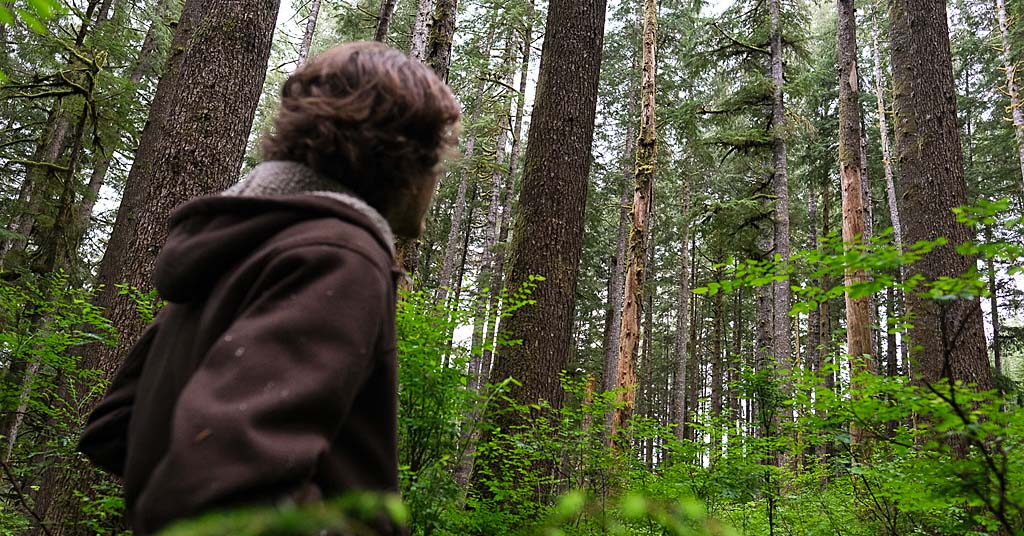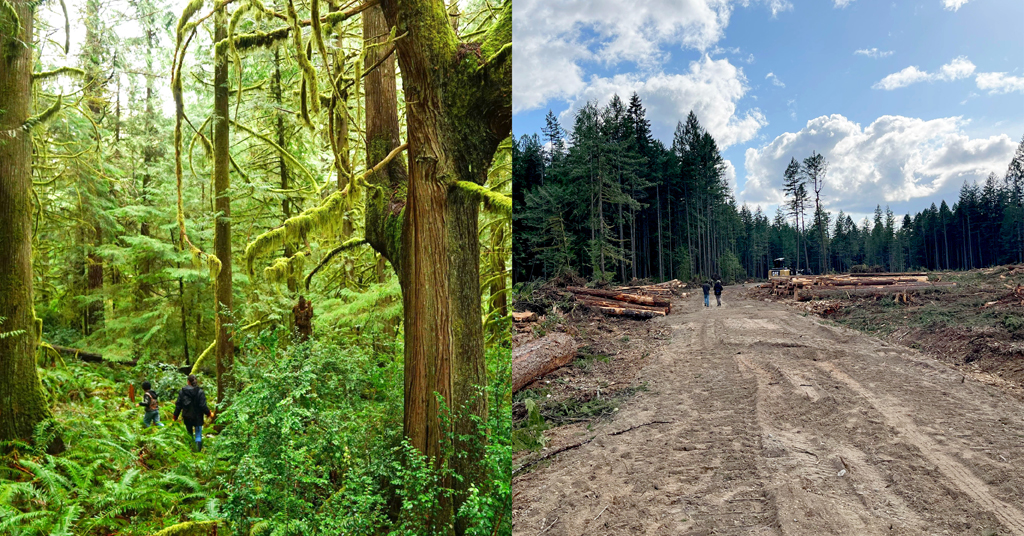Among enviros, government agencies and logging interests, a war of words is raging over the future of our forests

Multi-versed: Loaded rhetoric typifies conversations about forests between loggers, conservationists and government agencies. The public is increasingly confused. Illustration: Mackenzie Miller
By Nathan Gilles. October 10, 2024. In 2019, conservation activist and longtime Washington state resident Stephen Kropp did something he’d never done before: he explored a forest managed as state trust land by the Washington State Department of Natural Resources.
“It was this beautiful, old stand of trees, the kind of thing you’d expect to see in one of the state parks and not on the state trust lands, which are managed primarily for timber production,” Kropp recalls.
DNR manages roughly 2.4 million acres of state trust forests in the state of Washington, which are run for timber production.
Revenue from the sale of the timber goes to various public trustees, including counties and school districts.
Kropp says the trees he saw were older, “mature” second-growth trees that had grown naturally without human intervention.
The forest he visited also had many of the same “structural” features as an old-growth forest: dark forest floors (the result of closing canopies), as well as standing dead wood and large logs that provide habitat for plants and animals.
In the following years, Kropp visited similar forests on state trust lands.
He became concerned that few of these types of forests were left, especially at lower elevations. He decided that the forests needed saving, and for that he needed to raise public awareness.
The problem was, he didn’t know what to call these types of forests.
They needed a name, and the catchier the better.
“It occurred to me that I needed a way to succinctly describe these forests in a way that was compelling and that conveyed the importance of protecting these forests. ‘Naturally regenerated second growth, mature forests that preserve the biological, functional and structural legacies of the forests they replaced’ was not a very efficient way of describing the forest,” says Kropp.
He settled on “legacy forests.”
The name caught on and is now used by organizations and nonprofits around Washington, from the Black Hills Audubon Society to Western Washington University’s College of the Environment.
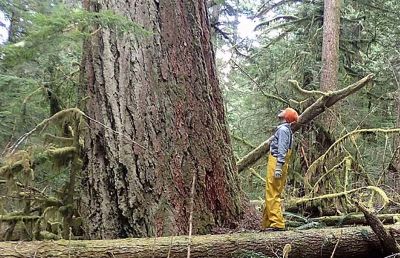
Stephen Kropp. Photo: Legacy Forest Defense Coalition
Now the founder of the nonprofit Legacy Forest Defense Coalition of Washington, Kropp has ramped up his mission of raising awareness about logging so-called “legacy forests” on Washington trust lands.
DNR doesn’t recognize the term “legacy forests” as either a scientific or legal term.
Timber interests also aren’t fond of the term.
And the term “legacy”, as it relates to a forest, means something different to the state and federal agencies that manage forests. This includes a U.S. Forest Service-administered grant program called the Forest Legacy Program. The goal of FLP, according to the program’s website, is to protect privately owned, actively logged “working forests” from being developed by “providing economic incentives to landowners to keep their forests as forests.”
“Legacy forests,” however, isn’t the only term used to describe older forests that’s been hotly contested recently.
The Forest Service and its critics have, in recent years, argued about how to define mature and old-growth forests.
At face value, these disagreements appear to be unimportant salvos of artful rhetorical language discharged between opposing camps or, worse, so much splitting of hairs.
But at heart, they’re arguments about value and ideology.
That’s because buried in their minutiae is an ongoing conversation about the future of our forests and the role the larger public should play in determining that future.
“Legacy” vs. “mature” forests
Nick Smith, public affairs director for the American Forest Resource Council, a trade association representing logging and related industries in the Pacific Northwest, doesn’t like Kropp’s term “legacy forests.”
“There is no definition of ‘legacy forests’ in any kind of science or silvicultural literature or any established knowledge of forestry that I know of,” says Smith. “This new effort on ‘legacy forests,’ in my opinion, is to further restrict active management on those lands that both state and federal agencies have determined are suitable for routine sustainable timber harvest.”
The term “active management” is frequently viewed with skepticism by conservationists, who see it as a synonym for “logging.” The term often contrasts with “passive management,” or leaving a forest to its own devices.
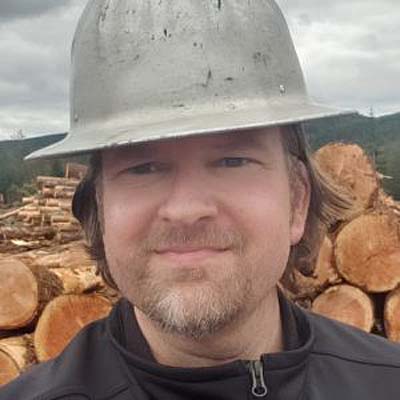
Nick Smith. Photo: AFRC
If one term seems redundant and the other oxymoronic that’s because “management” itself is generally defined as an activity.
“Active management” isn’t the only jargon logging interests have employed in recent years to push their bottom line and, critics claim, muddy the perceived impact of clear-cuts and other logging practices.
“Forest restoration” is a malleable term that to naïve ears might sound like a green-friendly strategy to rehabilitate once-healthy eco-systems, and in some instances that’s exactly how it’s used.
But it’s also increasingly employed by logging concerns in conjunction with “mechanized removal” (another euphemism for logging) of trees. In plainer language, along with other measures, a forest is “restored” after trees are “harvested”—meaning cut down.
“Reforestation,” according to American Forests, is undertaken in the interest of “maintaining tree diversity” and “returning forest composition and structure to a more natural state.”
Smith says the timber industry isn’t in the business of harvesting old-growth trees. He does, however, concede that most mills are in the business of harvesting mature trees, adding that it’s better to get mature wood from local forests than elsewhere.
“The bottom line is that consumers want to use wood,” says Smith. “I think the question is, where do we get our wood? Do we get it in Washington state under the strongest environmental laws and forest practices on the planet, or do we want to get it from other parts of the world that don’t share those standards?”
The state of Washington is also at odds with the term “legacy forests.”
“It [legacy forests] does cause a little bit of confusion from the scientific literature perspective,” says Dan Donato, a natural resource scientist at the Washington State Department of Natural Resources.
The term “legacy,” says Donato, is used very specifically in forest ecology and not in the way that Kropp now uses the term.
The Washington Department of Natural Resources has its own definitions for mature forests. Receiving these labels, however, confers no protective status if those trees grow on state trust lands.
Duane Emmons, assistant deputy supervisor for state uplands for DNR, goes a step further than his colleague, claiming that Kropp’s definition is ill-conceived.
He also calls into question how old some forests labeled as “legacy forests” actually are.
“We often see forests that were harvested pre-1945 that were then thinned in the 1980s or interplanted in the 1950s and then thinned in the 1980s called ‘legacy forests,’” says Emmons.
In an email to Columbia Insight responding to Emmons, Kropp wrote:
“Although most legacy forests pre-date WWII, there are many exceptions, and we DO NOT define legacy forests based on their origin date, age, or stage of development. We define legacy forests simply as ‘forests that retain significant genetic, biological, structural, and functional legacies of the natural and old-growth forests that once dominated the Pacific Northwest.’”
Kropp admitted this means that some “legacy forests” aren’t old enough to be considered “mature” forests.
For Emmons, the law concerning state trust lands makes his agency’s position clear.
Referring to a series of court decisions, Emmons says DNR has a fiduciary responsibility to create revenue for its trustees, be they schools or counties, and right now, that means producing timber.
“These are trusts. We have a duty to make them productive,” says Emmons.
Kropp, on the other hand, thinks the definition of “trustee” needs to be expanded to include all the people of Washington.
“It’s not as if DNR is managing these lands on behalf of some private trustee,” Kropp wrote in an email. “These are public lands that are managed on behalf of the public.”
Logging loopholes
All of this new jargon represents small linguistic skirmishes in a broader battle to define older forests at the national level.
In April 2022, the Biden Administration issued Executive Order 14072 directing the Forest Service and the Bureau of Land Management to “define, identify, and complete an inventory of old-growth and mature forests on Federal lands.”
The national inventory, which was completed in April 2023, was ordered in part as a way to determine if older forests on federal lands could be used to “retain and enhance carbon storage” as a natural solution to climate change.
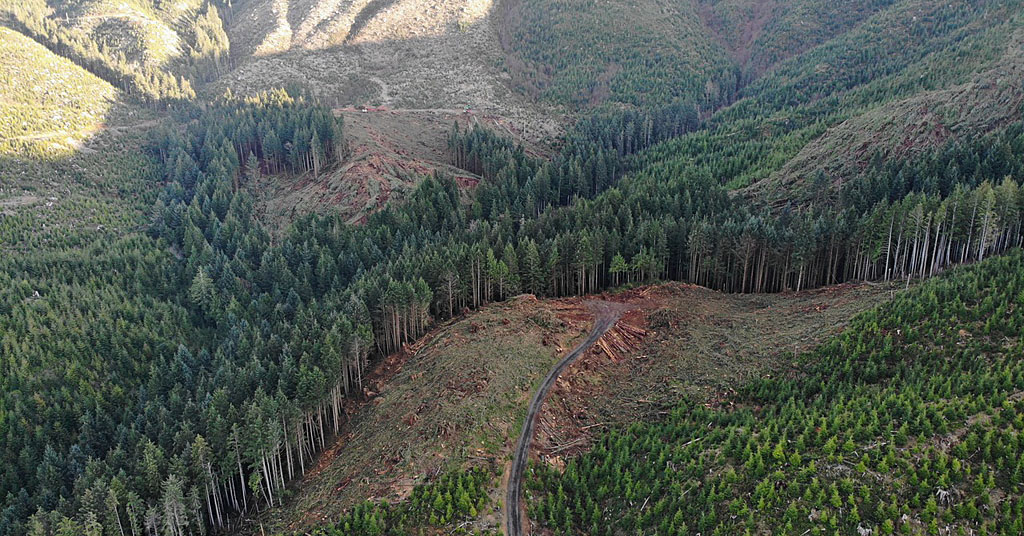
“Restoration” ready: After logging operations like this one in 2020 on Oregon Coast, forests are ripe for renewal. So say some. Drone photography: Dr. Trygve Steen
The executive order and the national inventory also resulted in the National Old-Growth Amendment, a plan that’s set to amend 128 forest plans nationwide.
Criticisms of the plan and its Environmental Impact Statement have included claims that the Forest Service has left too many loopholes for logging in old-growth forests.
Also included are claims that the agency has abandoned protection for mature trees altogether, something the agency disputes.
Jerry Franklin, professor emeritus at the University of Washington and something of a legend in the world of Pacific Northwest forestry science, is one prominent researcher claiming that the Forest Service is ignoring mature forests.
“The currently proposed Forest Service policy for implementing management of old-growth forests did not include mature at all,” says Franklin. “They totally ignored the mature forests.”
Franklin, who helped draft the original definitions of old-growth forests during the creation of the Northwest Forest Plan in the early 1990s—and who was a member of a federal committee that earlier this year released a suite of recommended modifications to the plan—says part of the problem is that mature forests aren’t well-defined.
“Probably no one has a clear idea from a scientific point of view, objectively of what a mature forest is,” says Franklin. “In the Pacific Northwest, we have a pretty good idea of what a mature and old-growth forests are, but that isn’t true nationally.”
What’s the best use for mature trees?
What’s less ambiguous is that there are more mature trees than old-growth left.
According to the Forest Service’s recent inventory, while old-growth forests cover 17% of federal lands, mature forests can be found on 45% of federal lands.
Logging interests now rely heavily on mature trees—much of them on public land—for timber.
Conservationists, by contrast, want to protect mature trees for ecological reasons and to help slow climate change by harnessing the trees’ ability to suck carbon out of the air by leaving them standing.
This makes mature forests something of a prize to be fought over.
Complex definitions of old-growth and “mature” trees make it harder for the public to be part of the decision-making process.
Meanwhile, state and federal agencies are caught somewhere in the middle.
This is the context in which the war of words is taking place, and it’s why Jim Furnish, retired deputy chief of the Forest Service turned Forest Service critic, says his former employer’s definitions of mature and old-growth forests need to be understood by the general public.
In an interview with Columbia Insight, Furnish called the Forest Service’s mature and old-growth definitions “mind-numbingly complex.”
“When you make things so complex, you’re basically leaving the public out. They can’t even begin to understand it,” says Furnish.
The Forest Service definitions created in response to EO 14072 first appeared in an official Forest Service document in April 2023 and later in a revised document published in April of this year.
Furnish says that when he heard the Forest Service would be reviewing its definitions in response to the executive order, he reached out to Jamie Barbour, assistant director for adaptive management at the Forest Service’s Monitoring and Analysis Team, which oversaw the implementation of the executive order, including the creation of the two definition documents, as well as the mature and old-growth inventory.
Furnish says he pleaded with Barbour to make the official mature and old-growth definitions simpler.
Barbour couldn’t confirm the communication with Furnish, telling Columbia Insight he’d spoken with Furnish on multiple occasions but was “not sure what he [Furnish] would suggest in this situation.”
Furnish says his suggestion was to simplify the definitions by setting nationwide age standards for mature and old-growth trees.
Adopting Furnish’s recommendation would have completely altered how the Forest Service creates definitions for older trees.
How old is old?
It might come as a surprise, but there is no clear standard definition of what makes a tree or forest mature or old-growth.
Old-growth forests are generally, and very loosely, defined as forests made up of trees that got very old without human aid.
But how old is old enough to be old-growth varies from 120 to 260 years depending on who is doing the defining.
The definition of mature trees is even more uncertain, with estimates running from 35 years at the low end to 200 years at the high end.
Most experts interviewed for this story, including Franklin, say most trees are mature at around 80 years of age. Furnish’s recommendation to Barbour was also to define “mature” starting at age 80. [A previous version of this story reported that Furnish recommended classifying old-growth forests at age 80. —Editor]

Can’t touch this? Old-growth (presumably) in the Cedar Flats Natural Area of the Gifford Pinchot National Forest. Photo: Jurgen Hess
However, age isn’t an absolute prerequisite for defining mature and old-growth forests, at least according to the Forest Service.
The agency uses age in some but not all of its official old-growth definitions. When age isn’t considered, tree diameter is used a proxy for age. Though some definitions use both age and diameter.
In fact, the common variable in Forest Service old-growth definitions appears to be variation itself.
The agency uses different definitions of old-growth depending on what Regional Office a forest is found in.
For instance, Region 6, which includes Oregon and Washington, has different definitions than Region 4, which includes Nevada, Utah and parts of Idaho and Wyoming.
What’s more, within regions, forest types can also receive different old-growth definitions.
These definitions, in turn, are set by dominant tree species—for instance, western hemlock or Douglas fir—which themselves might have different age and diameter requirements depending on where they are.
Also important for definitions of old-growth are “structural” characteristics, including downed and standing deadwood. Structural characteristics, age and/or diameter are then combined, along with how many older trees can be found per acre (this number can also vary).
Adding all these factors together, the agency determines whether a forest is old-growth or not.
Confusing code
Yet there’s still one more big wrinkle—the Forest Inventory Analysis codes.
The Forest Inventory Analysis is a long-term scientific monitoring effort and dataset run by the Forest Service to monitor the health of the nation’s forests.
Some but not all of the Forest Service old-growth definitions include FIA codes.
When it comes to mature trees, Forest Service definitions are both more and less straightforward regarding FIA codes: all official definitions of “mature” forests are written predominately in FIA code in both the 2023 and 2024 definitions guidebooks.
Richard Birdsey, a retired Forest Service scientist and now senior scientist at the nonprofit Woodwell Climate Research Center in Massachusetts, says he agrees with Furnish that the Forest Service definitions of mature and old-growth can be confusing for non-experts.
Coding for mature definitions are particularly difficult for the non-expert to decipher, according to Birdsey.
“As described in the mature and old-growth documents, it is difficult for anyone to really understand the definitions,” Birdsey wrote Columbia Insight in an email. “One needs to study the [FIA] database manual to decipher the codes.”
For readers perplexed by what the FIA codes mean—including “ddiscore” and “badom”—both versions of the agency’s official definitions guidebooks provide tables explaining the codes. In both documents, FIA definitions can be found over 20 pages before the definitions of mature forests are first introduced.
Birdsey, who spent 15 of his 40 years at the Forest Service working on the FIA program, says the rationale behind the Forest Service definitions—including using different definitions for different forest types—makes ecological sense, but he insists the agency’s definitions are still too complicated.
“All I’m saying is they could be simplified and made standard,” says Birdsey. “They might not be perfect ecological definitions everywhere, but at least it would be a consistent approach that was a little easier to understand by the general public and still be useful.”
For his part, Barbour disagrees with Furnish and Birdsey’s contention that his agency’s definitions leave the public out.
“In terms of the non-expert, what we’re trying to describe is we’re working on this structural concept so that for someone who didn’t know anything about forests, if they were to look at these places, I believe that they would be able to say, ‘yeah, this looks like an old forest to me,’” says Barbour.
Back in Washington state, however, what an old forest looks like, let alone what it should be called, remains a topic of heated debate.
If the war over definitions used for older trees is any clue, whatever new criteria or jargon catches on—and with whom—will have more to do with values than mere words.



